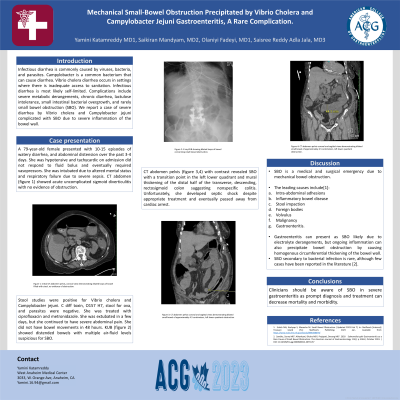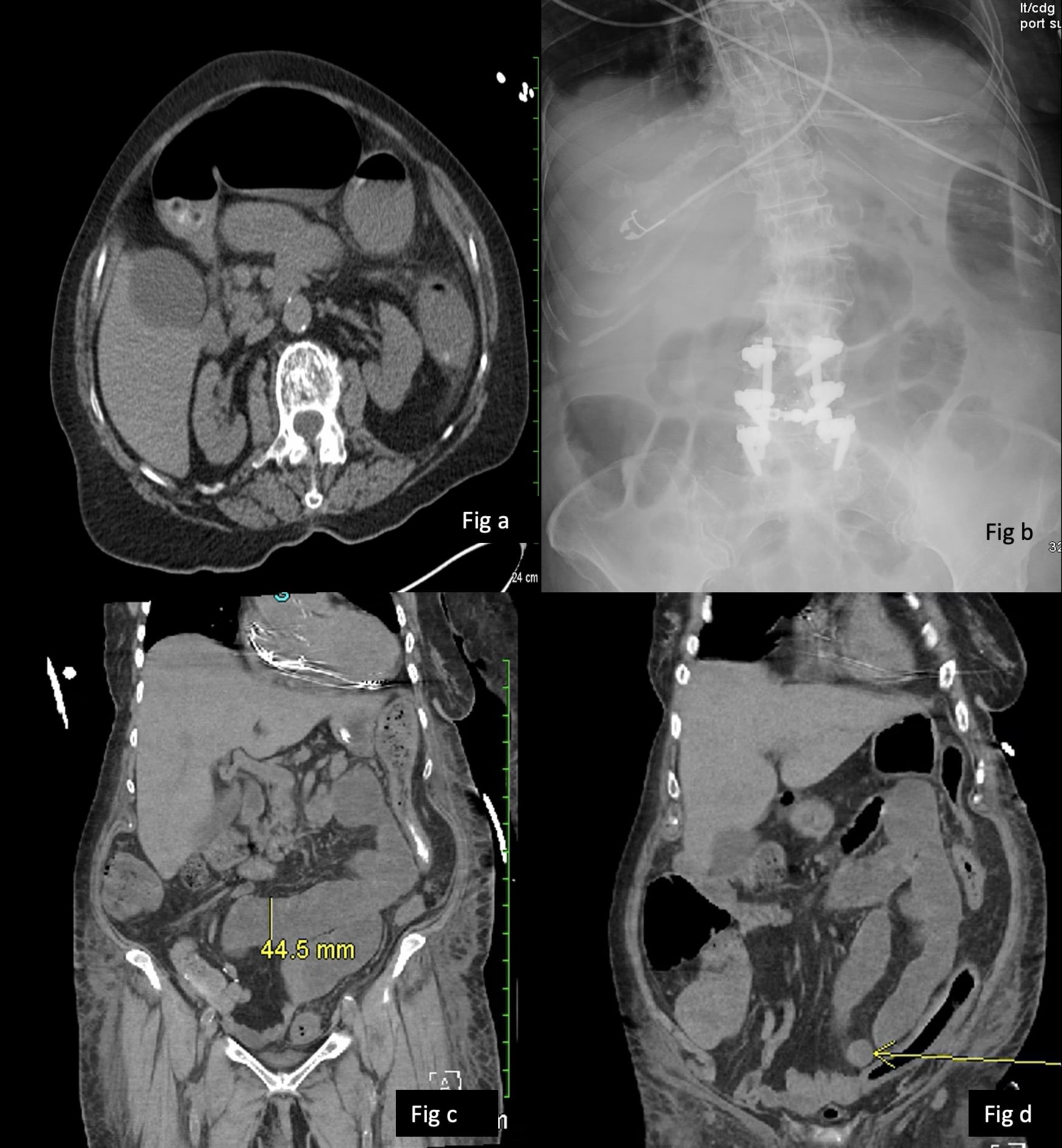Tuesday Poster Session
Category: Small Intestine
P4141 - Mechanical Small-Bowel Obstruction Precipitated by Vibrio Cholera and Campylobacter Jejuni Gastroenteritis, a Rare Complication
Tuesday, October 24, 2023
10:30 AM - 4:00 PM PT
Location: Exhibit Hall

Has Audio

Yamini Katamreddy, MD
West Anaheim Medical Center
Anaheim, California
Presenting Author(s)
Yamini Katamreddy, MD1, Saikiran Mandyam, MD2, Olaniyi Fadeyi, MD1, Saisree Reddy Adla Jala, MD3
1West Anaheim Medical Center, Anaheim, CA; 2South East Health, Dothan, AL; 3Centinela Hospital Medical Center, Inglewood, CA
Introduction: Infectious diarrhea is commonly caused by viruses, bacteria, and parasites. Campylobacter is a common bacterium that can cause diarrhea. Vibrio cholera diarrhea occurs in settings where there is inadequate access to sanitation. Infectious diarrhea is most likely self-limited. Complications include severe metabolic derangements, chronic diarrhea, lactulose intolerance, small intestinal bacterial overgrowth, and rarely small-bowel obstruction (SBO). We report a case of severe diarrhea by Vibrio cholera and Campylobacter jejuni complicated with SBO due to severe inflammation of the bowel wall.
Case Description/Methods: A 79-year-old female presented with 10-15 episodes of watery diarrhea, and abdominal distension over the past 3-4 days. She was hypotensive and tachycardic on admission and did not respond to fluid bolus and eventually required vasopressors. She was intubated due to altered mental status and respiratory failure due to severe sepsis. CT abdomen (figure 1) showed acute uncomplicated sigmoid diverticulitis with no evidence of obstruction. Stool studies were positive for Vibrio cholera and Campylobacter jejuni. C diff toxin, O157 H7, stool for ova, and parasites were negative. She was treated with ciprofloxacin and metronidazole. She was extubated in a few days, but she continued to have severe abdominal pain. She did not have bowel movements in 48 hours. KUB (figure 2) showed distended bowels with multiple air-fluid levels suspicious for SBO. CT abdomen pelvis (figure 3,4) with contrast revealed SBO with a transition point in the left lower quadrant and mural thickening of the distal half of the transverse, descending, rectosigmoid colon suggesting nonspecific colitis. Unfortunately, she developed septic shock despite appropriate treatment and eventually passed away from cardiac arrest.
Discussion: SBO is a medical and surgical emergency due to mechanical bowel obstruction. The leading causes include intra-abdominal adhesions, inflammatory bowel disease, stool impaction, foreign bodies, volvulus, malignancy, and rarely gastroenteritis [1]. Gastroenteritis can present as SBO likely due to electrolyte derangements, but ongoing inflammation can also precipitate bowel obstruction by causing homogenous circumferential thickening of the bowel wall. SBO secondary to bacterial infection is rare, although few cases have been reported in the literature [2]. Clinicians should be aware of SBO in severe gastroenteritis as prompt diagnosis and treatment can decrease mortality and morbidity.

Disclosures:
Yamini Katamreddy, MD1, Saikiran Mandyam, MD2, Olaniyi Fadeyi, MD1, Saisree Reddy Adla Jala, MD3. P4141 - Mechanical Small-Bowel Obstruction Precipitated by Vibrio Cholera and Campylobacter Jejuni Gastroenteritis, a Rare Complication, ACG 2023 Annual Scientific Meeting Abstracts. Vancouver, BC, Canada: American College of Gastroenterology.
1West Anaheim Medical Center, Anaheim, CA; 2South East Health, Dothan, AL; 3Centinela Hospital Medical Center, Inglewood, CA
Introduction: Infectious diarrhea is commonly caused by viruses, bacteria, and parasites. Campylobacter is a common bacterium that can cause diarrhea. Vibrio cholera diarrhea occurs in settings where there is inadequate access to sanitation. Infectious diarrhea is most likely self-limited. Complications include severe metabolic derangements, chronic diarrhea, lactulose intolerance, small intestinal bacterial overgrowth, and rarely small-bowel obstruction (SBO). We report a case of severe diarrhea by Vibrio cholera and Campylobacter jejuni complicated with SBO due to severe inflammation of the bowel wall.
Case Description/Methods: A 79-year-old female presented with 10-15 episodes of watery diarrhea, and abdominal distension over the past 3-4 days. She was hypotensive and tachycardic on admission and did not respond to fluid bolus and eventually required vasopressors. She was intubated due to altered mental status and respiratory failure due to severe sepsis. CT abdomen (figure 1) showed acute uncomplicated sigmoid diverticulitis with no evidence of obstruction. Stool studies were positive for Vibrio cholera and Campylobacter jejuni. C diff toxin, O157 H7, stool for ova, and parasites were negative. She was treated with ciprofloxacin and metronidazole. She was extubated in a few days, but she continued to have severe abdominal pain. She did not have bowel movements in 48 hours. KUB (figure 2) showed distended bowels with multiple air-fluid levels suspicious for SBO. CT abdomen pelvis (figure 3,4) with contrast revealed SBO with a transition point in the left lower quadrant and mural thickening of the distal half of the transverse, descending, rectosigmoid colon suggesting nonspecific colitis. Unfortunately, she developed septic shock despite appropriate treatment and eventually passed away from cardiac arrest.
Discussion: SBO is a medical and surgical emergency due to mechanical bowel obstruction. The leading causes include intra-abdominal adhesions, inflammatory bowel disease, stool impaction, foreign bodies, volvulus, malignancy, and rarely gastroenteritis [1]. Gastroenteritis can present as SBO likely due to electrolyte derangements, but ongoing inflammation can also precipitate bowel obstruction by causing homogenous circumferential thickening of the bowel wall. SBO secondary to bacterial infection is rare, although few cases have been reported in the literature [2]. Clinicians should be aware of SBO in severe gastroenteritis as prompt diagnosis and treatment can decrease mortality and morbidity.

Figure: Figure 1: Initial CT abdomen pelvis, coronal view demonstrating dilated loops of bowel filled with stool, no evidence of obstruction.
Figure 2: Xray KUB showing dilated loops of bowel concerning small bowel obstruction.
Figure 3, 4: CT abdomen pelvis coronal and sagittal views demonstrating dilated small bowel of approximately 4.5 centimeters, left lower quadrant obstruction
Figure 2: Xray KUB showing dilated loops of bowel concerning small bowel obstruction.
Figure 3, 4: CT abdomen pelvis coronal and sagittal views demonstrating dilated small bowel of approximately 4.5 centimeters, left lower quadrant obstruction
Disclosures:
Yamini Katamreddy indicated no relevant financial relationships.
Saikiran Mandyam indicated no relevant financial relationships.
Olaniyi Fadeyi indicated no relevant financial relationships.
Saisree Reddy Adla Jala indicated no relevant financial relationships.
Yamini Katamreddy, MD1, Saikiran Mandyam, MD2, Olaniyi Fadeyi, MD1, Saisree Reddy Adla Jala, MD3. P4141 - Mechanical Small-Bowel Obstruction Precipitated by Vibrio Cholera and Campylobacter Jejuni Gastroenteritis, a Rare Complication, ACG 2023 Annual Scientific Meeting Abstracts. Vancouver, BC, Canada: American College of Gastroenterology.
